

COVEN BERLIN
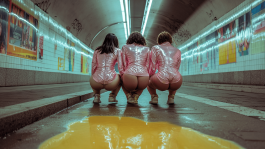
© COVEN BERLIN, 2025
You are warmly greeted on the sidewalk outside of the Nollendorfplatz Edeka with a firm gloved handshake from two white women who tell you, “Schön, Sie kennenzulernen,” as the U2 clambers down the tracks overhead. They are incredibly beautiful; both somehow familiar and totally unknown, and when they greet you they smile and look you squarely in the eyes. Their lips are full and plump, their teeth perfect little white pebbles nestled into impossibly pink gums. They look like a sapphic dental ad. Their names are Wilhelmine (Mine) zu Guschi and Sabine (Bine) von Bousen, but now you can’t remember which one is Mine and which one is Bine.
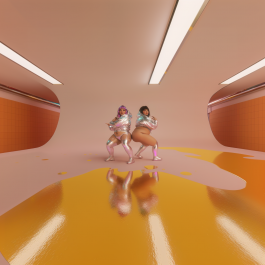
© COVEN BERLIN, 2025
They kiss each other briefly on the lips, with a flash of tongue. They tell you very flatly that they are sisters from the year 2099 and offer no further explanation. They look similar, but these girlfriends are clearly not identical sisters. Together they work as Tussicore Ensemble, working with “deeply held” embodied femme Tussi knowledge.
It’s a warm, but still breezy, July summer day in Nollendorfkiez and Berlin is celebrating pride month. Mine and Bine tell you that pride month in the future is different. They smile when they say this and reach for each other, but there is something slightly off. Mine begins to wrap one of Bine’s curls of hair around her finger while she chews her gum. She tells you that in 2099 pride celebrates Nicht-KI-Menschen (NiKIMe) to raise visibility of NiKIMes like Mine and Bine, who are proud members of the diverse queer NiKIMe community, which is largely overlooked and pushed out of art spaces in 2099 in favor of autonome funktionale KI-Wesen (AFuKIWe). NiKIMes have a Deutsche Bank pride parade every July called NSD that showcases the lesbian NiKIMes in the Berlin police force. After 2030, it will happen in collaboration with Staatsräson für Alle with different events held at the Berlin Mall. Mine and Bine don’t want to give too many spoilers from the future of Germany. They pause and Bine tilts her head, a smile just a little too sharp. “The parades,” she says, as if answering a question no one has dared to ask, “are both everything and nothing.”
“In the end, love is love,” says Mine, as she looks longingly into Bine’s eyes. Bine blinks back at her lovingly, and slowly they both turn back to you and the walking tour group which has now grown outside of Edeka to at least 15 people.
“Today you’ll be embarking on the Pisswashing Tour,” Mine announces. “A Tussicore Ensemble classic. We guide you from one public toilet to the next, leaving traces where the city never expected them. I hope your daily fluid intake has been above average. With its numbers equaling nine, the year 2025 is the ninth year—that is why we are here. A year of completion, reflection, and humanitarianism, encouraging both personal growth and collective healing. Bine and I have traveled here from the future because this year, the last in a cycle, is our last window of opportunity.”
There is a pause. Nobody really gets it but nobody is surprised. Bine bites her lip as Mine proceeds: “Private mercenaries, autonomous weapons systems, ethnostates, Christian Zionism, technofeudalism: some of you will see the future Binchen and I live in, and others will co-parent in your polycules the people who may visit the Commerzbank NiKIMe space station named after Alice Weidel, two hours directly above BER.”
The sheer horror is visible on some faces—well-known nGbK people, young queers wearing heart-shaped sparkly zit patches, and, you assume, a scattering of tourists. “We are simply here to artistically intervene,” Mine says, her voice sharp and high-pitched, as if defending herself. “You also move through systems that celebrate and castrate, that co-opt and erase you. And let’s not bring up your grandfathers!”
The mood has markedly shifted. These Labubu-toting, Gina, George, and Lucy lesbians seemed whatever at first, but now it’s gone a little too far. You uneasily shift your weight from one foot to the other. You thought this would be a nice historical tour, not a performative statement piece. They’ll probably do that slow trembling move that you see in every fucking dance piece in this town. You should have seen another exhibition at C/O; you love portrait photography. You begin to think about how best to sneak out once this tour begins, if it ever does.
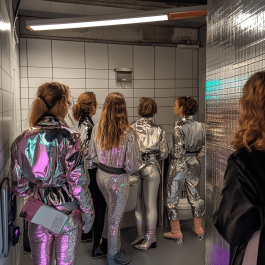
© COVEN BERLIN, 2025
Bine, previously quiet, clears her throat loudly and abruptly changes subjects: “The first public toilet sewage system made on earth was in the city of Mohenjo-daro (Mound of the Dead) in what is today Pakistan around 2500 BC. Berlin only began with public toilets sometime in the 1800s. With increased urbanization, Berlin built about 100 public toilets, informally referred to as Café Achteck, or Octagon Café, for its signature octagonal shape. Many were destroyed in the second world war, but some remain in use, or have become places to eat, like the Burgermeister at Schlesi, or clubs, like Zur Klappe at Mehringdamm.”
Encouraged by this informative turn, the group walks to the first stop: two blocks south in Winterfeldtplatz, in front of Gleditschstraße 5, Toilet ID Nr. 917. “In 2018, the city partnered with the company Wall to build 278 new public toilets,” Bine narrates. “Lovely 917 is just one.” The group sits on the red brick boundary forming a semicircle around it. The sound of a healthy stream of urine hitting the pissoir wall is audible.
“All toilets are unisex and wheelchair accessible, aligned with Berlin’s so-called Toilet Concept: economically efficient, hygienic, safe, gender equal and inclusive, environmentally friendly, well-designed, and—oh yes—promoting… communication,” Bine says coyly. Mine’s eyebrows theatrically dance.
“Well, my sweet non-AI humans of the past,” Mine announces, “what the city didn’t account for is how Berliners would use these toilets to take drugs. Shocking, I know. After years of conceptualizing ideal public toilets, no one imagined they would become Fixerstuben. Nollendorfplatz has changed into a cisgay haven, worshipping the illusion of the post-HIV male ideal: muscled and lean, hyper-masc tops. The city seems to have willfully forgotten its most vulnerable queers: drug users, sex workers, unhoused and undocumented queers.”
They reach for each other. “This is where pisswashing comes in.”
“Piss is our most precious fluid,” they announce in near-perfect unison. “The cyborgian wellspring of our being: where drugs and microplastics swirl, filtering toxins from our blood. Abundant, repulsive, unstoppable. No cheaper or more accessible weapon exists against the city’s glossy surfaces.”
“The future is a death cult,” Bine continues, voice low and steady, “and the most radical way we intervene is to insist on a world where life exists in all its variations. Pisswashing makes private fluids public and demands that queer spaces resist being sanitized. Only then does everyone have room to remain.”
Mine adds, whispering, “Not metaphor, method. A baptism of resistance, an unflinching embrace of what must be shared—whatever that really means.”
The group has grown quiet. Someone coughs. Another person shuffles forward, uncertain but unwilling to be the one who refuses. Bine and Mine stand hand in hand, their faces solemn, beatific, terrifying in their beauty.
Just as Bine and Mine are preparing to lead the group in their great communal release, a voice rises from the back. “Wait,” they say in German with an obvious American accent, “why are you two railing against pinkwashing when you obviously love it? You brag about Deutsche Bank Pride, the police parade, Staatsräson for All. You say you’re against assimilation, but everything you’ve described is assimilation.”
The group freezes. A woman half-crouched with her pants around her knees pauses mid-motion.
Bine’s smile doesn’t falter. Eyes glittering, she tilts her head. “Ah, but isn’t that the point? We live inside the contradiction. Pinkwashing is both our poison and our cure. There is no pisswashing without it, my dear.”
The inciting person mutters, “Bullshit,” and walks away. The sisters don’t follow them with their eyes. They’ve already returned to their circle.
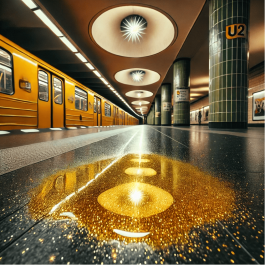
© COVEN BERLIN, 2025
“Now,” Bine announces, louder, “let us begin.” Mine whispers something to Bine; they laugh softly, tenderly, and begin lowering themselves against the wall. A long pause, then the unmistakable sound of liquid hitting tiles echoes into the shack.
The crowd stirs. A few join hesitantly, bound by some strange, collective spell. Streams overlap into a hissing chorus.
You feel the pull, the collapse of dignity into collective purpose. You imagine stepping forward, joining the warm mist of rebellion. But instead, you step back. No one notices as you slip behind the semicircle.
At the edge of the square, you pause. Sounds carry faintly: a chorus of laughter, splashing urine, and traffic. For an instant, you think you hear your own name, spoken in unison by two familiar voices. You turn, but the scene is already gone. Only the gray-tiled shack remains, humming with sunlight, a faint trickle glistening down its side.
You walk faster, refusing to look back again.
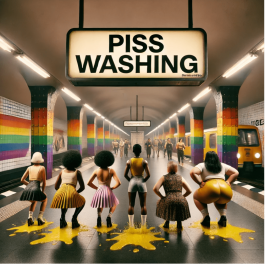
© COVEN BERLIN, 2025
COVEN BERLIN is a queer art collective focused on feminism, love, gender, and sexuality. Founded in 2013, it blossomed when some queers answered a Craigslist ad. Current members are Harley Aussoleil, Frances Breden, Lorena Juan, Judy Landkammer, Kiona Hagen Niehaus, and Louise Trueheart.
As a group, COVEN BERLIN wants to create an open sphere to defy systemic violence and inequality, and is devoted to emotional processing, collective healing, political reassessment, paying fairly, and supportive time management strategies. The collective nurtures cultural work, in Berlin and online, in the form of embodied affective research and digital hybrid curatorial approaches, always with a breath of humor.
COVEN BERLIN had an intense bout of years curating and being featured in exhibitions and events from 2018 to 2023. Since then, we have become something of a little snail: we move slowly, lay lots of eggs with many different partners in the form of long and short-term research projects, and slime around carrying our growing online magazine and full moon newsletter in our shell wherever we dwell, online and up close.
Our last project was SICK IN THE CITY in collaboration with University of Atypical (Belfast) funded by Cultural Bridge 2025. Our work has been shown at Gallery Kula in Belgrade (2023), Gallery Škuc in Ljubljana (2022), feldfünf and Villa Merkel in Esslingen (2022), ICI Berlin Writing Letters to Extraterrestrials (2021), Kunstpunkt, Berlin Art Week SOMABOG(2021), feldfünf e.V. DANK MEMES 4 DANK TIMES, AN INVITATION TO SINK INTO THE BOG (2021), Galerie Im Turm, Berlin BURLUNGIS(2020); GMK Galeria, Zagreb EXTRA+TERRESTRIAL (2019); Project Space Festival, Berlin PROBAND WERDEN (2019); Gallery of Academy of Fine Arts, Prague Neodaddyism 💯 (2019); nGbk, Berlin LUCKY(2018); Schwules* Museum, Berlin EXTRA+TERRESTRIAL (2018); Municipal Gallery Arsenał, Poznań, Polen BEDTIME (2018); Hybrid Art Festival, Madrid Labor or Labor (2018).